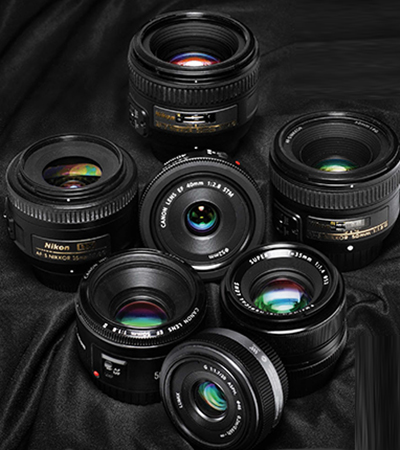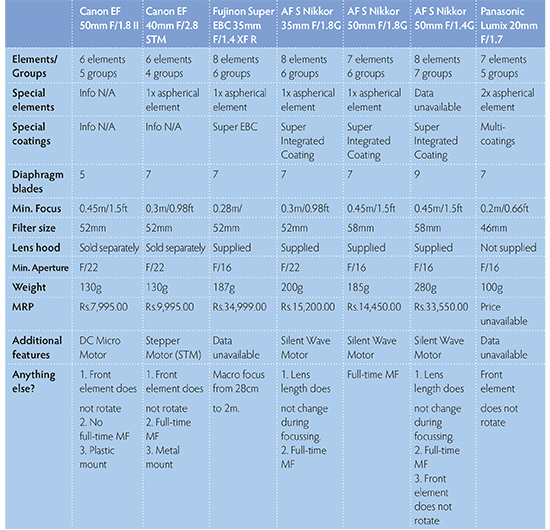- Canon EF 50mm F/1.8 II
- Canon EF 40mm F/2.8 STM
- Fujinon Super EBC 35mm F/1.4
- AF S Nikkor 35mm F/1.8G
- AF S Nikkor 50mm F/1.8G
- AF S Nikkor 50mm F/1.4G
- Panasonic Lumix 20mm F/1.7
A ‘normal’ lens is one that has a focal length equal to (or close to) the diagonal of the format it is used with. To give an example, a 43mm lens is a true ‘normal’ lens on a full-frame (36x24mm) 35mm camera body (but a 50mm lens is easier to manufacturer and hence we consider a 50mm lens as a ‘normal’ lens for 35mm format). On APS-C bodies with crop factor of 1.5 and 1.6 respectively, a ‘normal’ lens would be about 28mm (28 x 1.5 = 42mm on Nikons and 28 x 1.6 = 44.8mm on Canons). On a Micro Four Thirds body, a ‘normal’ lens would be equal to 21mm. In this ‘shootout’ we shall consider the following lenses that more-or-less fit into the description of a ‘normal’ lens.
Canon EF 50mm F/1.8 II (used on a fullframe body)
Canon EF 40mm F/2.8 STM (used on a full-frame body)
Fujinon Super EBC 35mm F/1.4 (used on an APS-C body)
AF S Nikkor 35mm F/1.8G (used on an APS-C body)
AF S Nikkor 50mm F/1.8G (used on a full-frame body)
AF S Nikkor 50mm F/1.4G (used on a full-frame body)
Panasonic Lumix 20mm F/1.7 (used on Micro Four Thirds body)
Design & Build Quality
Build quality varied quite a bit, but then so did the prices. Generally, price and build quality go hand in hand. If you consider just the price, then even the least expensive (the Canon lenses) justified the build quality. The best overall build quality was offered by the Fujinon Super EBC 35mm f/1.4 XF R and the AF S Nikkor 50mm f/1.4G. By design, there was not much to choose, except that the Canon EF 40mm f/2.8 offers a STM (Stepper Motor) which eliminates autofocussing noise during video recording.
Ergonomics
Both the full-frame Canon lenses were tested using a EOS 6D body while the Fujinon lens was tested using a Fujifilm XE 1 body. A Nikon D600 body was used for the full-frame Nikon 50mm f/1.4 and f/1.8 lenses; while the AF S Nikkor 35mm F/1.8G was mounted on a APS-C sensor Nikon D7000 body. The Lumix 20mm f/1.7 was used on a Panasonic GF1 body (Micro Four Thirds). All the lenses were reasonably light in weight and were
easy to handle.
Performance
Though the camera/lens combos were lightweight, the tests were performed using a heavy-duty
tripod to avoid the possibility of camera movement during exposure.
Darkening of Corners with the Lens Wide Open
All the lenses in this test exhibited darkening of the corners. The worst offender was the Canon EF
40mm f/2.8, while the Nikon 50mm f/1.4 showed the least darkening at the corners with the lens
wide open.



